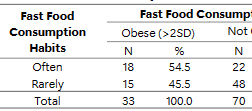Relationship Between Fast Food Eating Behaviour and Prevalence of Obesity in Children Aged 7-12 Years in Nganjuk, Indonesia
DOI:
https://doi.org/10.5281/zenodo.11067865Keywords:
Children, Eating Behaviour, Fast Food, ObesityAbstract
Background: Obesity is a common problem among children today. Obesity can cause negative health effects. The habit of consuming fast food can increase various diseases such as hypertension, obesity and diabetes. Objective this study to determine the association of fast food consumption behavior with the incidence of obesity in school-aged children 7-12 years. Methods: This research design is an observational analytic survey with a cross-sectional approach. The sampling technique used Simple random sampling with a sample of 103 children. Results: Based on the results of the study there were 32% of students who were obese, respondents in the category of frequent fast food consumption 38.8% and the results of statistical tests showed that the p-value = 0.025 ≤ α 0.05 then Ha was accepted and Ho was rejected. Conclusion: There is a relationship between fast food consumption behavior and the incidence of obesity in school-age children aged 7-12 years at SD Negeri 1 Kutorejo. It is expected that students reduce the consumption of fast food that contains high sugar, salt, flour, and fat by consuming nutritious and balanced foods, and spending time in physical activity.
Downloads
References
Aprilia, A. (2015). Obesity in Elementary School Children. Majority, 4(7), 45–48. http://juke.kedokteran.unila.ac.id/index.php/majority/article/viewFile/1446/1281
Nganjuk District Health Service. (2016). Nganjuk District Health Profile 2016. 1–207. https://dinkes.nganjukkab.go.id/index.php
Nganjuk District Health Service. (2018). Nganjuk District Health Profile 2018. 1–141. https://dinkes.nganjukkab.go.id/index.php
Hadi, R. F., Afriwardi, A., & Jurnalis, Y. D. (2015). Description of obesity in elementary school students at SD Pertiwi and SD Negeri 03 Alai Padang. Andalas Health Journal, 4(1), 249–253. https://doi.org/10.25077/jka.v4i1.230
Hanifah, K. (2020). Factors in the Occurrence of Obesity in Children. Higeia Journal of Public Health Research and Development, 1(3), 6
Hudha Endityawan, Rahayu Budi Utami, & Agus Khoirul Fuadi. (2020). The Relationship between Dietary Patterns and the Occurrence of Obesity in School Age Children at Sdn Kutorejo 1, Kertosono District, Nganjuk Regency. Sabhanga Journal, 1(1), 38–45. https://doi.org/10.53835/vol-1.no.1.thn.2019.hal-38-45
Indanah, Sukesih, Fairuzzah, & Khoiriyah. (2021). Obesity in toddlers. Journal of Nursing and Midwifery Science, 12(2), 242–248
Indonesian Ministry of Health. (2018). 2018 Basic Health Research Results. Indonesian Ministry of Health, 53(9), 1689–1699.
Indonesian Ministry of Health. (2018). Risk Factors for Obesity in Children - Chapter 1. P2PTM Indonesian Ministry of Health. https://p2ptm.kemkes.go.id/infographic-p2ptm/obesitas / factor -risiko-obesitas-pada-anak-bagi-pertama
Indonesian Ministry of Health. (2018). Risk Factors for Obesity in Children - Chapter 2. P2PTM Indonesian Ministry of Health. https://p2ptm.kemkes.go.id/infographicp2ptm/obesitas/page/45/factorrisikoobesitas-pada-anak-bagi-kedua
Indonesian Ministry of Health. (2020). Genetic factors are one of the causes of obesity. P2PTM Ministry of Health of the Republic of Indonesia. https://p2ptm.kemkes.go.id/infographic-p2ptm /obesitas/politik-merupakan-lahan-satu-besar-obesitas
Indonesian Ministry of Health. (2022). Prevent obesity in children. https://yankes.kemkes.go.id/view_article/921/prevent-obesitas-pada-anak
Indonesian Ministry of Health. (2023). The Effect of Fast Food on Adolescent Health. RSST Health Promotion Team. https://yankes.kemkes.go.id/view_article/2182/ Influence-makanan-cepat-saji-terhadap-kesehatan- juvenile
Misnadiarly. (2007). Obesity as a risk factor for several diseases. Jakarta: Popular Torch Library
Pratiwi, W. R., & Sapriyani. (2018). Mothers' knowledge and attitudes about obesity in toddlers. Iqra Health Scientific Journal, 6. Retrieved from https://stikesmu-sidrap.e-journal.id/JIKI/article/download/53/42.
Sartika, R. A. (2011). Risk Factors for Obesity in Children 5-15 years in Indonesia. Depok: Makara, Health, Vol.15, No.1, June 2011: 37-43.
Wawan & Dewi. (2011). Theory and Measurement of Knowledge, Attitudes, and Human Behavior. Yogyakarta: Nuha Medika.
WHO (2013). Obesity and overweight. World Health Organization Western Pacific Region. http://www.who.int/mediacentre/factsheets/fs311/en/ index. html
World Health Organization. (2014). Obesity and Overweight. Fact Sheet No. 311.
WHO. (2018). Noncommunicable Diseases. In Heart of Africa: Clinical Profile of an Evolving Burden of Heart Disease in Africa. https://doi.org/10.1002/9781119097136.
Yaslina, Anggraini, M., & Nordila. (2014). Food Consumption Behavior with the Incidence of Obesity in School Age Children. Pioneer Health Journal, 23–29.
More
Downloads
Published
Issue
Section
License
Copyright (c) 2024 Ficco Public Health Journal

This work is licensed under a Creative Commons Attribution 4.0 International License.

